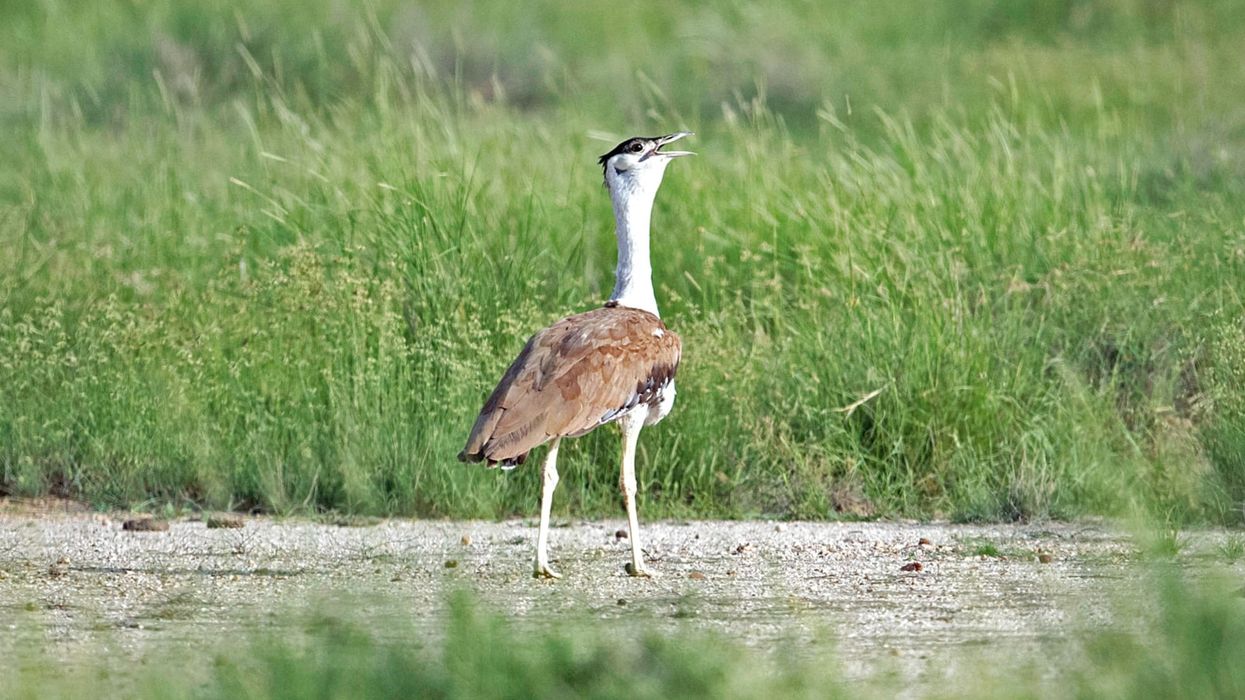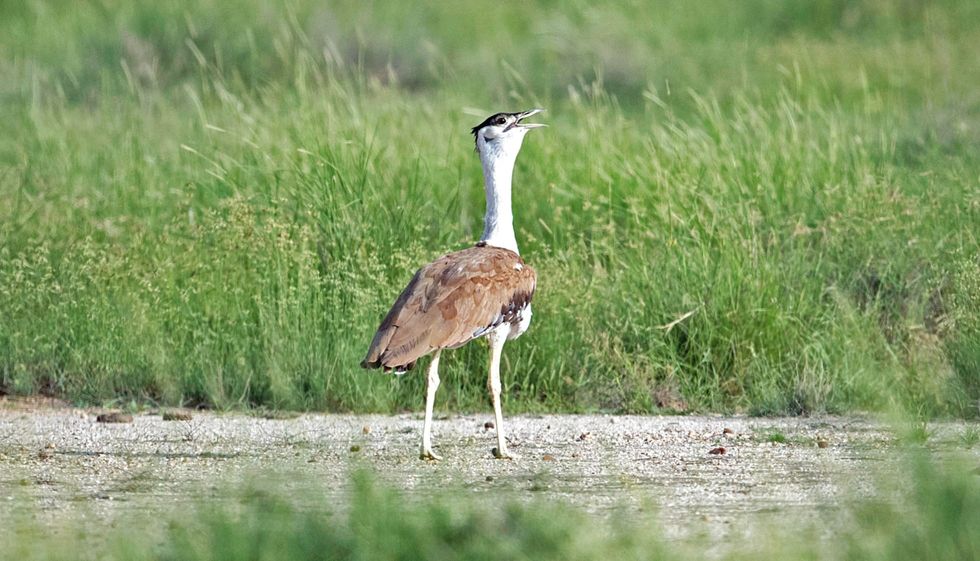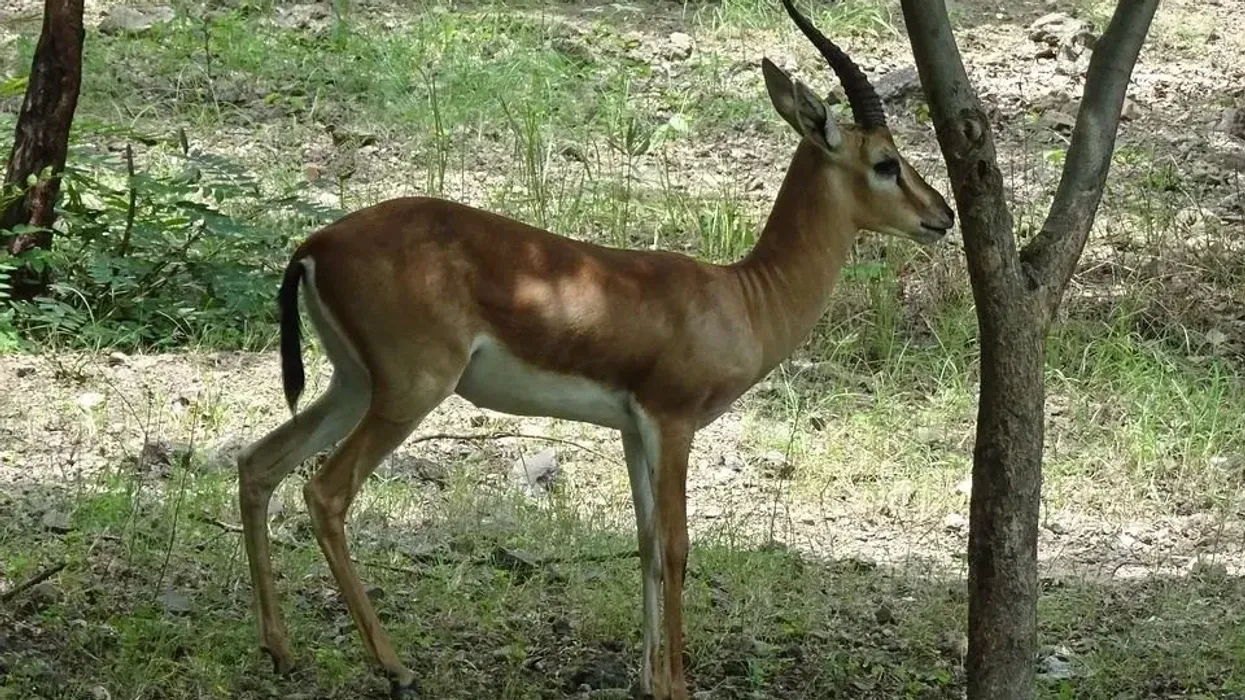Great Indian bustards (Ardeotis nigriceps) are found in the Indian states of Rajasthan, Madhya Pradesh, Maharashtra, Andhra Pradesh, and Gujarat. An estimated 250 individual birds were recorded in the year 2011, but the number further reduced to 150 individuals by the year 2018.
The main causes behind the declining populations of this bird are hunting activities and the loss of its habitat. The distribution of these birds is in habitats where they can easily locate food while also being away from hunting activities.
This would usually be the semi-arid grasslands of India and Pakistan, where there is open country, thorn scrub, and tall grass interspersed with cultivation.
The basic diet of this bird is insects, beetles, grass seeds, berries, rodents, reptiles, groundnut, millets, and pods of legume. They are not too aggressive in nature.
Their breeding season usually takes place between March and September; also, this bird is capable of year-round breeding. After the breeding season, the males leave, and the females become the only caretaker of the chicks.
The males of this species take no part in the incubation and care of the eggs. At times, in order to protect their chicks from predators and a few other dangers, the females start flying zigzags with dangling legs.
They are often seen carrying their young ones under their wings. The males become sexually mature at age five or six, whereas the females acquire sexual maturity as early as age two or three.
Here we have lots of interesting facts on the pyrrhuloxia that everyone will enjoy. If you like these, do also read our greater white-fronted goose facts and steamer duck facts too.
Great Indian Bustard Interesting Facts
What type of animal is a great Indian bustard?
A great Indian bustard (Choriotis nigriceps) is a Critically Endangered species of bird. The population of these birds is located in the regions of India and Pakistan.
What class of animal does a great Indian bustard belong to?
The class of animal that a great Indian bustard belongs to is Aves. These are considered to be one of the heaviest flying birds. These are considered diurnal birds that are said to be usually active in the morning or evening hours.
How many great Indian bustards are there in the world?
According to the researches conducted by the IUCN, the estimated size of the population of the great Indian bustard is about 50-249 mature individuals. Currently, this bird species has been declared as Critically Endangered under Schedule I (Wildlife Protection Act 1972), and their population is decreasing.
The largest existing population of GIB birds could be found in Rajasthan, India, of around 175 existing individuals.
Where does a great Indian bustard live?
A great Indian bustard (Ardeotis nigriceps) is found living in dry and semi-dry grasslands, grass plains, and scrublands. Nests of these birds are found on the ground.
Their habitat is sometimes considered to be the same as that of the blackbuck. Their largest populations are found in the Thar desert in Rajasthan, India. Undistributed and less degraded grassland sites are where breeding usually takes place for this bird.
What is a great Indian bustard's habitat?
The basic habitat of a great Indian bustard is the dry and semi-dry regions of central and western India and Pakistan. They are seen in many Indian states like Rajasthan, Maharashtra, Madhya Pradesh, Andhra Pradesh, and Gujarat.
Who do great Indian bustards live with?
The great Indian bustard is found living in flocks with its own kind.
How long does a great Indian bustard live?
The estimated lifespan of the great Indian bustard is about 12-15 years.
How do they reproduce?
The great Indian bustard is known to follow polygamy, where each male mates with several females. Their breeding season usually takes place between March and September.
This bird is also capable of year-round breeding when in nature. The males gather in groups called 'leks', where they gather in communal display sites to perform mating and courtship rituals for the females. Once mating is done, the female lays about one big egg, but clutches of two eggs are not uncommon.
Their incubation period lasts for about one month after the breeding season, and the whole process after is taken care of primarily by the female bird. The chicks are ready to fledge after 30-35 days.
What is their conservation status?
As per the IUCN Red List, the conservation status of the great Indian bustard is now listed as Critically Endangered. This means that they are under the threat of becoming extinct.
The loss of their habitats, as well as overhunting, are the major reasons for the decline in the population of this species. However, various world wildlife conservation and nature protection programs have been put in place, keeping this bird protected.
Great Indian Bustard Fun Facts
What do great Indian bustards look like?
A great Indian bustard is a tall bird with a large horizontal body, a long neck having brownish patches, and long bare legs. They appear similar to the ostrich.
However, this species of birds could easily be distinguished by their black crown on the forehead, contrasting with the pale neck and head. Both the males and females grow to a similar size and weight, but the males tend to have a much larger black crown and a black band across their breasts.
Also, the crown of the head is black in color.
An adult GIB is about 47.2 in (1.2 m) tall. Both males and females are the same in size and are distinguished by the color of their feathers.
How cute are they?
Whether they are or aren't cute is subjective, but the popular opinion is that they are reasonably cute and majestic to behold.
How do they communicate?
They produce a large booming sound by inflating their gular pouch. The male GIB produces this sound in order to attract the female GIB.
How big is a great Indian bustard?
Great Indian bustards are around 47.24 in (1.2 m) tall. They are considered to be ten times bigger than a cat.
How fast can a great Indian bustard fly?
The approximate flying speed of a GIB is unknown.
How much does a great Indian bustard weigh?
A great Indian bustard (Ardeotis nigriceps) weighs around 33 lb (15 kg). They are also considered to be the heaviest flying birds.
What are the male and female names of the species?
This bird is generally identified as a male great Indian bustard or a female great Indian bustard.
What would you call a baby great Indian bustard?
The correct term for a baby GIB is a chick.
What do they eat?
The diet of a great Indian bustard comprises insects, beetles, grass seeds, berries, rodents, reptiles, groundnut, millets, and pods of legume.
Are they dangerous?
The great Indian bustards are not known to be dangerous. Most bustards are also harmless.
Would they make a good pet?
A GIB would not make a good pet since they are known to be living in open ground or grassland.
Did you know...
This species of the great Indian bustards are said to be smaller in size than the Kori bustard and the great bustard.
In certain regions like Rajasthan, the increased irrigation by the Indira Gandhi canal has resulted in increased agricultural activities and has altered the habitat of these habits, and has led to a decrease in the population of the great Indian bustards.
Hunting is considered to be one of the biggest threats to this species and is still quite prevalent in Pakistan.
Various wildlife protection programs have been appointed in order to protect this species of bird. GIB is protected under the wildlife protection act 1972.
In 2012, India launched a project to protect the great Indian bustards, it was a national conservation project which also helped in the protection of another bird, the Bengal florican. This conservation project was modeled after another famous conservation program called Project Tiger which was started to protect tigers across India.
The great Indian bustards are famously seen in the Desert National Park of Rajasthan along with blackbuck and Chinkara.
The great Indian bustards are not extinct in India. We can protect these birds by participating in the various programs initiated by the government and spreading awareness of the same. The Houbara bustard is also found in India, and it is known to migrate to the Indian subcontinent every winter.
In its native range, the great Indian bustards are known to be the largest land birds.
The major breeding habitat of this bird is central and western India and eastern Pakistan.
Rollapadu Wildlife Sanctuary is also known as the habitat of the GIB.
Which is the heaviest bird in India?
The heaviest bird in India is the great Indian bustard with the scientific name Ardeotis nigriceps. They are located in various states of India like Rajasthan, Maharashtra, Madhya Pradesh, Andhra Pradesh, and Gujarat.
Which national park is famous for the great Indian bustard?
Desert National Park is famous for its great Indian bustards. It is located in Rajasthan, India.
Here at Kidadl, we have carefully created lots of interesting family-friendly animal facts for everyone to discover! Learn more about some other birds from our Wompoo fruit dove facts and yellow-billed magpie facts pages.
You can even occupy yourself at home by coloring in one of our free printable great Indian bustard coloring pages.










